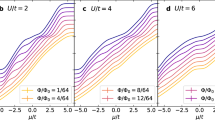Abstract
The extended Hubbard model [V. J. Emery,Phys. Rev. Lett. 58, 2794 (1987)] is used to study the copper-oxide plane of the high-T c superconducting material. Due to the Coulomb repulsion between the holes on oxygen and copper atoms, there exists an indirect attraction between oxygen holes. Correlation among holes will enhance rather than screen the attraction. Calculation based on the Hartree-Fock and random-phase approximations show that it is quite large. A comparison with direct Coulomb repulsion shows that it is greater in a certain range of momentum transfer. It is sufficient to provide the pairing mechanism to give high critical temperature.
Similar content being viewed by others
References and Notes
R. Putz, B. Ehlers, L. Lilly, A. Muramatsu, and W. Hanke,Phys. Rev. B 41, 853 (1990).
Hideo Aoki and Kazuhiko Kuroki,Phys. Rev. B 42, 2125 (1990).
J. E. Hirsch, S. Tang, E. Loh, Jr., and D. J. Scalapino,Phys. Rev. Lett. 60, 1668 (1988).
V. J. Emery,Phys. Rev. Lett. 58, 2794 (1987).
For example, P. B. Littlewood, C. M. Varma, S. Schmitt-Rink, and E. Abrahams,Phys. Rev. B 36, 12371 (1989).
The structure factor (cosqxa+cos qya)/2 could be different for different ground states.
It is interesting to compare the Vind with the results of P. B. Littlewood, C. M. Varma, and E. Abrahams,Phys. Rev. Lett. 63, 2602 (1989). Though they did not consider the indirect attraction in Eq. (6), they found various screening and antiscreening behavior for effective O-Cu, O-O, and Cu-Cu interactions.
W. L. McMillian,Phys. Rev. 167, 331 (1968). In his notations,λ≈0.82,μ*≈0.3, and Θ≈0.6 eV.
For estimations, see W. S. Hybertsen, M. Schluter, and N. E. Christiansen,Phys. Rev. B. 39, 9028 (1989).
Author information
Authors and Affiliations
Rights and permissions
About this article
Cite this article
Hu, C.D. The indirect attraction between holes in the extended hubbard model. J Supercond 4, 481–484 (1991). https://doi.org/10.1007/BF00635868
Received:
Issue Date:
DOI: https://doi.org/10.1007/BF00635868



